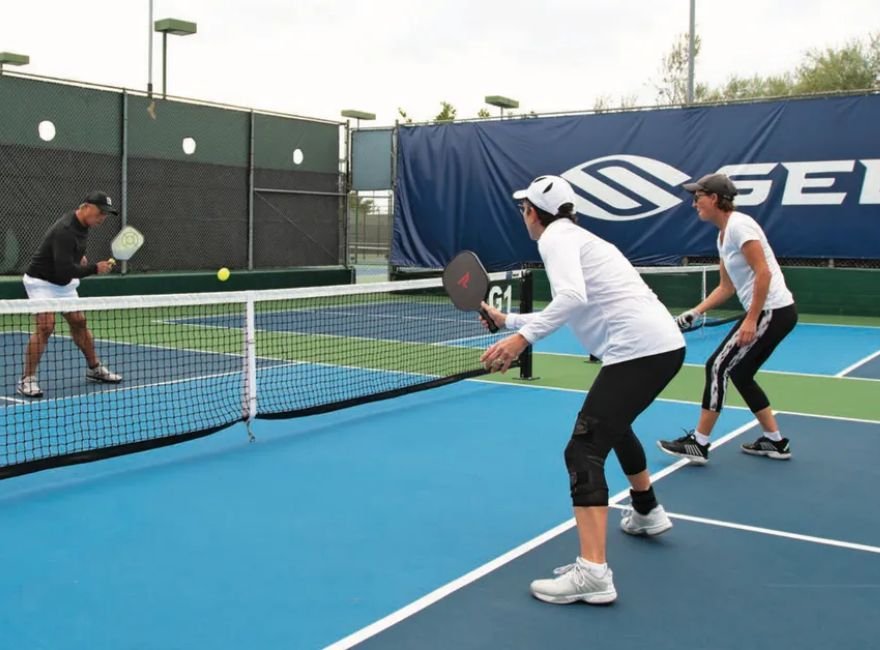Is it better to serve first in pickleball

As the paddles meet the plastic ball, a crucial decision looms over players: to serve first or receive first? It’s the pickleball conundrum that sparks debates and locker room discussions.
In this article, we’re dissecting the pickleball playbook to uncover the secrets behind serving first. Picture this: the court is set, the tension is palpable, and the question echoes in your mind — should you take the lead or let the opponent serve up the challenge?
Get the full scoop on “Pickleball Rules, Ratings, and Techniques” by visiting our blog.
Join us as we unravel the pros and cons, providing you with the playbook to make the decisive call on whether being the first to serve holds the key to pickleball victory.
Pros & Cons of Serving First

Pros:
Serving first in pickleball isn’t just about a polite exchange of shots; it’s a strategic move that can tip the scales in your favor. The primary advantage lies in the control it hands you over the game’s tempo. When you step up to serve, you set the rhythm, deciding whether to send a thunderous shot or a spin-infused curveball, throwing your opponent off balance.
But it’s not just about style points. A well-executed serve becomes a potent weapon, putting your opponent on the defensive and paving the way for you to seize control of the point. Spot a weak link in your opponent’s game? Serving first lets you exploit it, be it a mobility hiccup or a penchant for unforced errors. Moreover, serving is not just a formality; it’s the gateway to scoring. In pickleball, you must be on the serving team to earn points. Serving first means scoring first, instantly catapulting you into the lead. As you initiate the rally, you hold the reins, directing the ball to exploit your opponent’s vulnerabilities.
Powerful servers rejoice – serving first lets you launch the ball past your opponent with finesse. An unreturned serve or one veering out of bounds becomes your express ticket to quick points. It’s not just about serving; it’s about serving strategically to gain an early advantage.
Cons:
Serving first in pickleball may seem like stepping into the spotlight, but it comes with its share of pitfalls. One significant drawback is the risk factor associated with that initial serve. If your serve veers off-course and misses the mark, you gift your opponent an open invitation to seize control of the point. The missed serve not only hands them an advantage but can also prove demoralizing, disrupting your rhythm and leaving you scrambling to regain momentum.
Pressure becomes an unwelcome companion when you’re the first to serve. In the crucible of competitive play, the spotlight is on you to kick off the match with precision. The added burden of setting the tone for the entire game can be mentally taxing. As you stand on the court, paddle in hand, the weight of expectations can cast a shadow on your performance, making the opening moments more challenging than ever.
Navigating the fine line between a powerful serve and the risk of a miss becomes a delicate dance, and the consequences of a misstep can reverberate throughout the game. While serving first offers control and strategic advantages, it also demands a mental fortitude to weather the potential pitfalls, ensuring that the advantages outweigh the disadvantages in the pursuit of pickleball glory.
Pros & Cons of Receiving First

Pros:
As the pickleball court beckons, the choice of receiving first unveils its own set of advantages, challenging the conventional wisdom of serving supremacy. Opting to receive isn’t merely a courteous gesture; it positions you strategically for the game ahead.
Receiving first means being the first to face the serve, allowing you early access to the net area. In a sport where positioning is paramount, this can be a game-changer. By standing closer to the net, you’re ready to pounce on any opportunity, turning the tables on your opponent’s serving prowess. In the scoring dance of pickleball, being on the receiving team doesn’t mean being at a disadvantage. While your counterparts on the serving end must grapple with the pressure of initiating the rally, you, as the receiver, have the chance to observe and adapt. This observational advantage provides crucial insights into your opponent’s game, allowing you to anticipate their moves and weaknesses.
Another perk of receiving first is the chance to break the rhythm. By returning the serve effectively, you disrupt the server’s plan, injecting an element of unpredictability into the game. This disruption can be particularly effective against opponents who rely heavily on a consistent serve strategy. In the doubles arena, receiving first presents a unique opportunity. While the serving team may amass points until an error costs them their service, you, as the receiving team, get the chance to serve back-to-back, potentially building momentum and flipping the score in your favor.
Cons
While the allure of receiving first in pickleball may seem tempting, it comes with its own set of challenges. Opting to be on the receiving end means relinquishing the control that serving provides over the game’s initiation. You find yourself reacting to the serve, adapting to the pace and spin dictated by your opponent.
One notable drawback is the limited opportunity to exploit your opponent’s weaknesses from the get-go. Unlike the server who can strategically target vulnerable areas, the receiver must quickly adjust to incoming shots, making it harder to take advantage of observed weaknesses. Receiving first means playing catch-up, reacting rather than dictating the flow of the game. In the realm of scoring, being on the receiving team poses a unique challenge. While a strong return may win you the rally, it doesn’t contribute to your point tally. To score, you must transition to the serving side. This dynamic places an added burden on receivers to not just respond effectively but also to seize the serving opportunity to register points.
Moreover, in the context of doubles play, being the first receiver doesn’t necessarily put you at an advantage. The serving team in doubles has the chance to accumulate points until they falter, losing their service. This structure means that even if you successfully navigate the challenges of receiving, the serving team has the potential to build a lead before your turn to serve arrives.
Tips for better First Serve

- Play Aggressively and Unpredictably: Take advantage of the serving opportunity to play aggressively and keep your opponent on their toes. Incorporate tricks and skill shots into your serves to add an element of unpredictability. Avoid falling into predictable patterns, limiting your opponent’s time to prepare for your strategic attacks.
- Balancing Risk and Reward: Recognize that scoring points sometimes involves taking calculated risks. While a forceful serve might occasionally miss, the ones that land can be more challenging for your opponent to return.
- Minimize Margin of Error: Keep a small margin of error for your serves to avoid losing points due to balls going out of bounds. Precision is key; a serve that stays within the boundaries is crucial for maintaining control in the game.
- Harness Power in Your Serve: Infuse your serves with maximum power by utilizing your entire body. Incorporate a powerful swing by engaging your hips and shoulders, complemented by the force generated from your elbow and wrist.
- Targeting Weaknesses: Identify your opponent’s weaker hand or foot and strategically target that area during your serves. Launch the ball deep into their service box, putting pressure on their weaker side and increasing the likelihood of gaining an advantage.
- Precision Matters: Aim for the heel of your opponent’s weaker side as it tends to cause more difficulties in returning the ball. Precision in targeting specific areas adds another layer of strategy to your serves.
- Strategic Positioning After Serve: Maintain a manageable distance from the net after serving to be prepared for the return. Avoid being stranded in the front, especially if your opponent decides to hit the ball hard and deep into your area, making it challenging for you to respond effectively.
Let’s sum it all up.
We’ve unraveled the serving secrets. It’s not just about hitting the ball – it’s about being the dance captain, setting the rhythm, and throwing in a surprise move or two. Serving is a mix of power and fancy footwork, a dance of strong shots and tricky spins.
But, hold up! Receiving first has its cool moves too. You get a head start to the net, disrupt the rhythm, and spy on your opponent’s dance style. It’s like being the first on the dance floor, stealing the spotlight with some unexpected twirls.
So, whether you’re leading the dance with powerful serves or rocking the floor with snappy returns, pickleball is a lively dance. It’s a shuffle of strategies, a dance of serves and returns, and a celebration of surprises.
Finally, let’s have a quicker look at the most frequently asked questions.
Is it better to serve first or second?
It depends on your playstyle and strategy. Serving first gives you control and a chance to set the tone, while receiving first allows you to observe and adapt.
How do you decide who serves first in pickleball?
Typically, a coin toss or a simple rally determines who serves first. The winner of the toss or rally gets to choose whether to serve or receive.
Does it matter where you serve in pickleball?
Absolutely! Strategic serving is key. You can target specific areas, exploit weaknesses, and control the game’s tempo. Precision in your serve placement can make a significant difference.
How do you serve effectively in pickleball?
To serve effectively, incorporate power by using your body weight, hips, shoulders, and a strong swing. Target your opponent’s weaker side, aim for the heel, and maintain a manageable distance from the net after serving. Adding variety to your serves keeps your opponent guessing and enhances your overall effectiveness.
